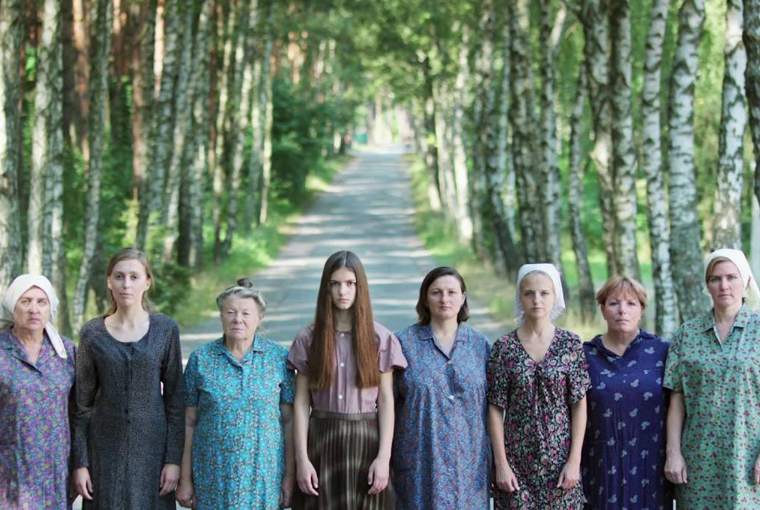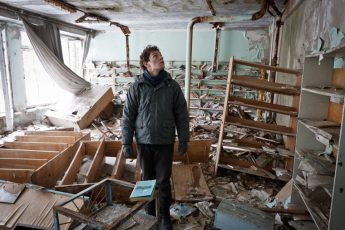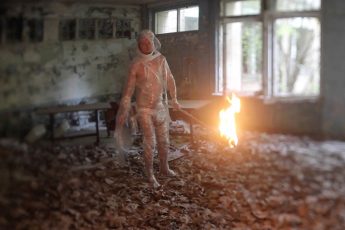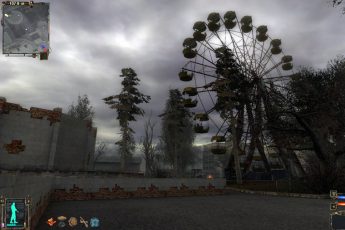No One Knows What Chernobyl Is
Pol Cruchten’s Voices from Chernobyl (La supplication, 2015)
Vol. 65 (May 2016) by Ivette Löcker
Pol Cruchten’s new film Voices from Chernobyl begins with panorama shots of the nuclear power station of Chernobyl. It is a monstrosity looming ominously into the landscape which, at the same time, is almost beautiful to look at, with its museum aesthetics, bathed in the warm light of the morning sun. The film shows the reactor blocks, which have been out of operation since the late 2000, in intercuts again and again, as close-ups of the outside walls or as backdrops for people fishing in the former cooling pond in the foreground. The enormous new dome that vaults over the old sarcophagus and that surrounds the damaged fourth tower blinks peacefully from the distance at night.
The term “sarcophagus” is misleading, since the interior is anything but dead. Etymologically, sarcophagus means “flesh-eating”, which is in turn an apt metaphor for the catastrophe of Chernobyl. It is an ambiguous memorial to the Soviet Union, whose decline sharply accelerated after the nuclear accident in 1986. It is also a relic of past times when the civil use of nuclear technology was celebrated as a progressive achievement with promises for the future. Few other images remind us more powerfully of the risk of human-made technology or of the tragedies of the people who became victims of this catastrophe.
One could ask why we need yet another film about Chernobyl thirty years after the atomic accident. Hasn’t everything already been said and written about the catastrophe and its victims? Haven’t all those involved or affected already been interviewed in uncountable documentaries? And how can a film make something invisible — namely, radiation and its effects — visible?
“No one knows what Chernobyl is”, is the first sentence heard in the film off screen. It is a defining motto and the point of departure for the cinematic search for possible answers, descriptions, and ways to approach the phenomenon of “Chernobyl.” Perhaps the truth about Chernobyl lies in the stories of the sufferers who still live with it today? Pol Cruchten based his film, which premiered in February 2016, on the book Chernobylskaya molitva — literally, “Chernobyl Prayer”— by the Belorussian author and Nobel Prize winner Svetlana Alexievich. Chernobylskaya molitva was published in Russia in the journal Druzhba narodov in 1997 and in an English translation as Voices from Chernobyl in 2005. Alexievich collected statements from interviews by liquidators and soldiers, by widows, scientists, politicians, mothers, and children and assembled them into impressive monologues. Adapted as literature, these interviews form a chorus of “voices” that makes the horrors of their individual experiences audible.
To get straight to the point, Cruchten manages to find a convincing cinematic form for this world after Chernobyl, for the reality of memories and facts that feeds on the tension between fiction and documentary. Shot on original locations in Ukraine and Belarus, the film creates a disturbingly poetic visual world of the post-apocalypse evoked by off-screen voices.
Voices from Chernobyl approaches this turning point in the history of civilization in scenic memories, dreamlike images, philosophical reflections, and intimate confessions. The stylized, perfectly composed images of landscapes and abandoned ruins of buildings powerfully contrast with the (invisible) danger that was and is still emitted by the contaminated area. Seemingly intact nature has reconquered the territory: plants continue to grow, everything is lush. The people who move around in this backdrop-like landscape seem lost and out of place. Strong and poetic images and an atmospheric soundscape produce a hypnotic vortex and contradict the horror inherent in the catastrophe. The beauty of the images (camera: Jerzy Palacz) evokes the association of an artificial, enraptured world, as if the catastrophe had never happened but was merely a product of our imagination – science fiction so to say.
The memories from off screen associate happy moments with philosophical and political reflections; stories about people who have lost their minds after the catastrophe follow unanswered questions about the origins of suffering. The voices express doubts about God and humanity and reflect on their role in the world. We do not learn any names, only professions; these are the stories of former liquidators, physicians, journalists, teachers. The corpses of husbands are described as “radioactive objects.” “Why did we keep silent when we knew?” asks a high-ranking scientist: “We obeyed without muttering because of party discipline. We believed in a just society, where man is the supreme value.” A boy asks why nobody helped the animals in the zone: “Why couldn’t they save the animals which were left over there?”
The stories get under our skin and never become maudlin laments. The perspective is never reduced to an accusation directed at Soviet bureaucracy and policies. Its main purpose is to ask how people will deal with their situation in the future. Sometimes the stories from off screen blend; the people in the film are not always those who are speaking or being discussed. This can be confusing at times, but it keeps the images and words from being unambiguous. They make us aware that although human lives are indeed buried beneath the sarcophagus of Chernobyl, their stories are not. And the film reminds us in passing that the half-life of memory is often too short.
The film dramatizes the memories using Ukrainian actors whose faces are shown in close-ups; they often look directly at the audience. They lie in bed pensively or walk up and down the corridor of the hospital. Children play in front of a cottage. Militia members evacuate an old peasant woman, a man walks up the stairs to his office and leafs through documents, sitting beneath the portrait of Mikhail Gorbachev, the General Secretary of the Central Committee of the Communist Party of the Soviet Union at the time. People walk on the street, past houses, across meadows. Their long walks seem to be pacing off space. The camera follows them entering buildings, rooms, factories, and apartments of former residents of what is now a restricted area. Surprisingly, a feeling of proximity is thus evoked: a certain familiarity arises amid the eeriness of the place.
Dreamlike shots and scenes evoke specific worlds of emotions and ideas. A window is opened unexpectedly and reveals a blooming forest; a door opens in a bright room, blinding the images with too much light; a woman who is recalling her deceased child looks through an imaginary window through which a playground is vaguely visible. Doors and windows are recurring motifs and are associated with symbols of hope. Particularly moving memories and dreams take on a surrealistic visual quality. One person stands in a room and it starts to rain. Parts of the ceiling fall down. A woman sits in an abandoned factory as a flock of black birds flies up. She remembers the night when her husband died. An isolated wooden cottage goes up in flames and collapses.
It becomes clear that Pol Cruchten was inspired by Andrej Tarkovsky’s poetic visual worlds.1 Slow tracking shots, the motifs of the mirror and of reflections, of apples and horses and aerial photographs are employed as visual cues. In terms of the subject matter, the conflict between individual and collective, between individual opinion and faith in something bigger, is also reminiscent of Tarkovsky. Take Tarkovsky’s film The Mirror (Serkalo) for example, which mixed documentary material, personal memories, and fictional scenes. But whereas Tarkovsky’s “complicated diving into the forest of consciousness, with their dark areas and clearings, their mazes and unexpected open strips”2 seems like a filmic, confusing labyrinth and is distinguished by a complex structure, Cruchten provides us with a thread to pass through his “Chernobyl labyrinth”: namely, the motif of love and its power, which ultimately enables people to preserve their humanity despite the loss of their illusions and faith.
Voices from Chernobyl impressively sheds light on the existential dimension of the turning point that Chernobyl represents. It is a film about memory and history falling apart, about the discrepancy between perception and reality. It argues for a documentary form of the culture of memory that preserves individual, sensory experience and enables outsiders to experience it emotionally and intellectually. And therein lies the answer to the question why we need another film about Chernobyl.




Leave a Comment